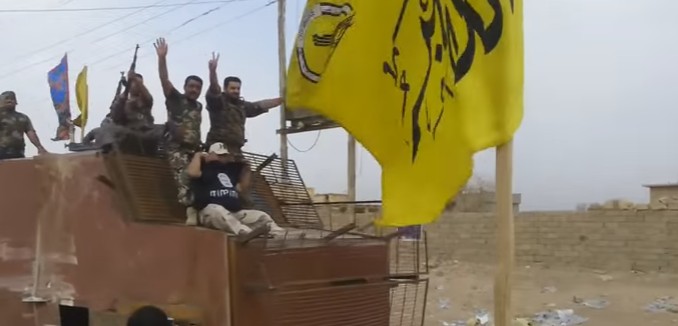Iraq’s prime minister officially incorporated the Iran-backed, terrorist-led Popular Mobilization Front (PMF) into his nation’s armed forces, cementing Tehran’s influence in the country, the Long War Journal reported on Thursday.
Iraqi Prime Minister Haidar al-Abadi decided to incorporate the PMF as an “independent military formation” within the Iraqi army in February, according to an official government document called Office Order 91, which was just made public.
The PMF was established two years ago after Iraqi clerics called on citizens to take up arms in support of the Iraqi military and police forces, which had been overwhelmed by the Islamic State. Established militias, including many that are backed by Iran and previously fought against U.S. and British forces in Iraq, answered the call and became the core group within the PMF.
According to Office Order 91, the PMF will report directly to the “general commander of the armed forces,” which is the Iraqi prime minister. Despite being incorporated into Iraq’s military forces, Office Order 91 specifies that the PMF will retain its “staff, brigades, and members.” For example, Abu Mahdi al-Muhandis kept his status as operations leader for the PMF, now with government approval. Muhandis was listed as a specially designated global terrorist by the U.S. Treasury Department in 2009.
Even though the PMF claim to be non-sectarian, “its brigades have been accused of razing Sunni towns and have even threatened Christians in Baghdad,” the Journal noted. Human Rights Watch called on Iraq’s government on Sunday to ban PMF groups with records of “summary killings, enforced disappearances, torture, and the destruction of homes” from the government’s operations in Mosul.
Despite these concerns, al-Abadi effectively cemented the PMF as a parallel military organization similar to Iran’s Islamic Revolutionary Guard Corps (IRGC), with which it has extensive ties. While not all militias within the PMF answer to Iran, top PMF commanders have publicly spoken of their admiration for Iran’s supreme leader and the chief of the IRGC’s elite Qods Force, and “the network backed by IRGC has the most sizable, experienced, strongest, organized, trained, and funded militias,” the Journal wrote. “The experiences of the IRGC in Iran and Hezbollah in Lebanon serve as precedents for how this Iraqi network can expand its influence.”
Office Order 91 will thus “[institutionalize] Tehran’s influence in the country,” the Journal observed.
In I Saw the U.S. Hand Iraq Over to the Iranians. Is the Whole Region Next?, which was published in the February 2015 issue of The Tower Magazine, Michael Pregent described how Iran gained a foothold in Iraq.
Iranian-backed Shia militias changed the demographics of Baghdad by targeting and killing charismatic Sunni leaders throughout the city. Sunni men of military age were rounded up and executed, with one left alive to tell the story to other Sunnis. These extra-judicial killings were often conducted by uniformed security forces with vehicles from the ministries of health and transportation. These ministries were headed by members of the Badr Corps, the Islamic Supreme Council of Iraq, and the OMS—all militant Shia groups.
In effect, American fear of a Ba’athist return to power allowed Iran to become the guarantor that Baghdad would remain in Shia hands—or, more accurately, Shia who were friendly toward Iran.
There was little we could do to stop this process. I was part of several efforts to curb sectarian violence and Iranian influence in Iraq. At one point, I was tasked with identifying sectarian Shia figures in the government’s security and intelligence apparatus. We developed a list of the top 50 sectarian actors in Iraq and soon realized that removing them from their positions would essentially require the overthrow of the Iraqi government.
[ Photo: Stahlgewitter Syrien / YouTube ]




